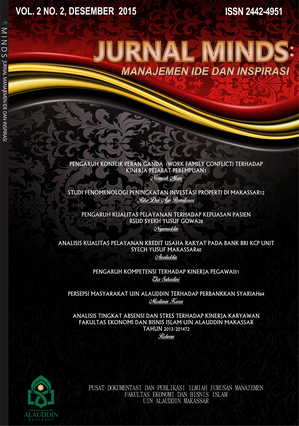Date Log
Copyright (c) 2021 Muh. Haerdiansyah Syahnur

This work is licensed under a Creative Commons Attribution 4.0 International License.
Determination of Internet Banking Customer Satisfaction - Study at SOE Bank in Indonesia
Corresponding Author(s) : Muh. Haerdiansyah Syahnur
Jurnal Minds: Manajemen Ide dan Inspirasi,
Vol. 8 No. 1 (2021): June
Abstract
This study seeks to identify the role of perception of information technology, service quality, and trust on customer satisfaction of internet banking users in several State-Owned Enterprises (SOE) Banks in Indonesia. The study involved 228 respondents from BBRI, BMRI, and BBNI. The stages in data analysis involve the classical assumption, validity & reliability, and effect test using PLS-SEM. The results accept all hypotheses with positive and significant effects. This study finds that the optimal use and application of information technology systems can increase perceptions of internet banking use on customer satisfaction at SOE banks in Indonesia.
Keywords
Download Citation
Endnote/Zotero/Mendeley (RIS)BibTeX
References
Ahmad, & Pambudi, B. S. (2014). Pengaruh Persepsi Manfaat, Persepsi Kemudahan, Keamanan Dan Ketersediaan Fitur Terhadap Minat Ulang Nasabah Bank Dalam Menggunakan Internet Banking (Studi Pada Program Layanan Internet Banking BRI). Journal of Management Studies, 8(1), 1–11.
Amijaya, G. R. (2010). Pengaruh Persepsi Teknologi Informasi, Kemudahan, Resiko Dan Fitur Layanan Terhadap Minat Ulang Nasabah Bank Dalam Menggunakan Internet Banking (Studi Pada Nasabah Bank BCA) [Universitas Dipanegoro]. http://eprints.undip.ac.id/22558/1/GILANG_RIZKY_AMIJAYA.pdf
Davis, F. D., Bagozzi, R. P., & Warshaw, P. R. (1989). User Acceptance Of Computer Technology : A Comparison Of Two Theoretical Models *. 35(8), 982–1003.
Fahrial, F. (2018). Peranan Bank dalam Pembangunan Ekonomi Nasional. Ensiklopedia of Journal, 1(1), 179–184.
Farizi, H., & Syaefullah. (2013). Pengaruh Persepsi Kegunaan, Persepsi Kemudahan, Persepsi Risiko Dan Kepercayaan Terhadap Minat Menggunakan Internet Banking. Jurnal Ilmiah Mahasiswa Fakultas Ekonomi Dan Bisnis, 1–18.
Ghozali, I. (2011). Aplikasi Analisis Multivariate Dengan Program SPSS. Universitas Diponegoro.
Hair, J. F., Money, A. H., Samouel, P., & Page, M. (2007). Research methods for business. Education+ Training.
Hutauruk, D. M., & Laoli Noverius. (2019, September 24). Transaksi mobile dan internet banking di sejumlah bank meningkat tajam - Page all. https://keuangan.kontan.co.id/news/transaksi-mobile-dan-internet-banking-di-sejumlah-bank-meningkat-tajam?page=all
Kasmir. (2014). Bank dan Lembaga Keuangan Lainnya. PT Rajagrafindo Persada.
Khan, M. S., & Mahapatra, S. S. (2009). Service quality evaluation in internet banking: an empirical study in India. International Journal of Indian Culture and Business Management, 2(1), 30–46.
Kotler, P., & Keller, K. L. (2012). Marketing Management. Prentice Hall.
Kotler, P., & Lee, N. R. (2009). Up and Out of Poverty: The Social Marketing Solution. Pearson Education, Inc.
Lau, G. T., & Lee, S. H. (1999). Consumers' trust in a brand and the link to brand loyalty. Journal of Market-Focused Management, 4(4), 341–370.
Lovelock, C. H., Widyantoro, A., Samosir, M., & Wright, L. K. (2007). Manajemen Pemasaran Jasa. Indeks.
Marcel, Davidson, 2003. Service Quality in Concept and Theory. Published by American Press, USA.
Mayer, R. C., Davis, J. H., & Schoorman, F. D. (1995). An integrative model of organizational trust. Academy of Management Review, 20(3), 709–734.
Trimulato, T. (2017). Analisis Potensi Produk Musyarakah terhadap Pembiayaan Sektor Riil Umkm. Jurnal Ekonomi & Studi Pembangunan, 18(1). https://doi.org/10.18196/jesp.18.1.3830
Trimulato, T. (2016). Sharia Bank Product Development through Mudhrabah Investment. Shirkah: Journal of Economics and Business, 1(3), 311-326. doi:https://doi.org/10.22515/shirkah.v1i3.24
Parasuraman, A. (1997). Reflections on Gaining Competitive Advantage Through Customer Value. 25(2), 154–161.
Parasuraman, A., Zeithaml, A., & Berry, L. (2012). of Expectations as a Standard in Measuring Comparison Service for Quality : Implications Further Research. Journal of Marketing, 58(1), 111–124.
Pertumbuhan Internet Banking di Indonesia - SHARINGVISION. (2015). Anonim. https://sharingvision.com/pertumbuhan-internet-banking-di-indonesia/
Pratomo, Z. P. (2017). Analisis Pengaruh Persepsi Kemudahan Penggunaan Teknologi Informasi Dan Kualitas Pelayanan Terhadap Loyalitas Nasabah Yang Dimediasi Oleh Kepuasan Nasabah Pada PT Bank Mandiri Cabang Jakarta R. P. SOEROSO [Universitas Mercubuana]. https://repository.mercubuana.ac.id/38743/
Ribbink, D., Riel, A. C. R. Van, Liljander, V., & Streukens, S. (2004). Comfort your online customer : quality , trust and loyalty on the internet. Managing Service Quality, 14(6), 446–456. https://doi.org/10.1108/09604520410569784
Robbins, S. P., & Judge, T. A. (2015). Perilaku Organisasi Organizational Behavior -16/E (R. Saraswati & F. Sirait (Eds.); 16th ed.). Salemba Empat.
Setiawan, H., Minarsih, M. M., & Fathoni, A. (2016). Pengaruh Kualitas Produk, Kualitas Pelayanan Dan Kepercayaan Terhadap Kepuasan Nasabah Dan Loyalitas Nasabah Dengan Kepuasan Sebagai Variabel Intervening (Studi Kasus Pada Nasabah Koperasi Rejo Agung Sukses Cabang Ngaliyan). Journal of Management, 2(2).
Siddiqi, K. O. (2011). Interrelations between service quality attributes, customer satisfaction and customer loyalty in the retail banking sector in Bangladesh. International Journal of Business and Management, 6(3), 12-36.
Soegoto, A. S. (2013). Persepsi nilai dan kepercayaan terhadap kepuasan dan dampaknya terhadap loyalitas konsumen. Jurnal EMBA: Jurnal Riset Ekonomi, Manajemen, Bisnis Dan Akuntansi, 1(3), 1271–1283.
Soelistya, D., & Agustina, H. (2017). Analisis Teknologi Informasi Mobile Banking Dan Persepsi Risiko Transaksi Terhadap Kepuasan Nasabah ( Studi Kasus Bank Mandiri Syariah Cabang Jemur Handayani Surabaya ). Accounting and Management Journal, 1(2), 89–100.
Syafrullah, M. J., & Wardhana, A. (2015). Pengaruh Kualitas Layanan Internet Banking Bank Mandiri Terhadap Kepuasan Nasabah Bank Mandiri Dengan Menggunakan Metode Webqual (studi Kasus Mahasiswa Telkom University). EProceedings of Management, 2(2).
Syahnur, M. H., Basalamah, J., & Gani, A. A. (2020). Customer Experience Factor Analysis Towards Customer Satisfaction Online Shopping. Jurnal Analisis Bisnis Ekonomi, 18(2), 83–94.
Syahnur, M. H., Soeharijanto, M., & Tazlie, L. (2018). Analisis Customer Experience Dengan Importance Performance Analysis ( IPA ) – Suatu Studi Pada Pelanggan Telkom Indihome. 5(2), 1–12.
Tjiptono, F. (2000). Prespektif Manajemen dan Pemasaran Kontemporer. Andi.
Tjiptono, F., & Chandra., G. (2011). Service, Quality and Satisfaction (3rd ed.). Andi.
Utami, S. (2015). The influence of customers' trust on customer loyalty. International Journal of Economics, Commerce and Management United Kingdom, 3(7), 638–653.
Wijaya, V. S., & Wismantoro, Y. (2017). Pengaruh Kualitas Produk Dan Persepsi Harga Terhadap Kepuasan Nasabah Melalui Kepercayaan Nasabah Asuransi Jiwasraya Cabang Kudus. Jurnal Penelitian Ekonomi Dan Bisnis, 2(2), 101–113.
Yuliaty, T. (2014). Pengaruh Kualitas Layanan Internet Banking Dan Brand Equity Terhadap Kepuasan Nasabah Pada PT. Bank Syariah Mandiri Kcp Medan Aksara. JURNAL MANAJEMEN & BISNIS, 14(02), 120–126.
Zeithaml, V., & Bitner, M. (2008). Service Marketing. McGraw Hill Companies, Inc.
